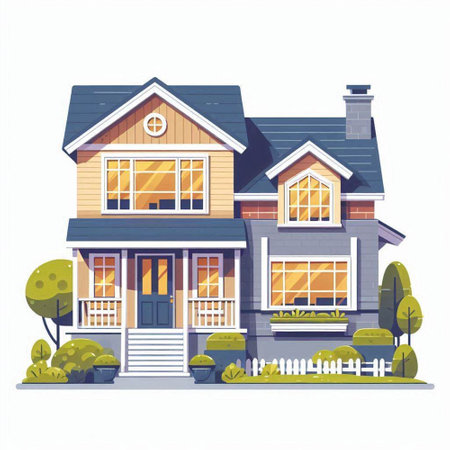1. Why a Home Inspection Matters
Buying your first home is an exciting milestone, but it also comes with a lot of responsibility. One of the most important steps in the home buying process is the home inspection. This is your chance to get a detailed look at the property before you finalize the purchase — and it can save you from unexpected costs or headaches down the road.
What Is a Home Inspection?
A home inspection is a professional evaluation of a homes condition, typically performed after your offer has been accepted but before closing. A certified inspector will examine the homes major systems and components to identify any existing or potential issues.
Key Areas Covered During an Inspection:
| System/Area | What’s Checked |
|---|---|
| Roof | Shingles, flashing, gutters, drainage |
| Foundation & Structure | Cracks, settlement, structural integrity |
| Plumbing | Pipes, water heater, leaks, drainage issues |
| Electrical System | Wiring, outlets, breaker panel, safety hazards |
| HVAC Systems | Heating and cooling function, age, maintenance needs |
| Windows & Doors | Seals, operation, energy efficiency concerns |
| Attic & Insulation | Ventilation, moisture levels, insulation quality |
| Pest/Damage Signs | Termite activity, rodent damage, mold or mildew presence |
Why It’s So Important for First-Time Buyers
If you’re new to buying real estate, a home inspection gives you peace of mind. It helps you understand exactly what youre getting into. Are there costly repairs needed right away? Are there safety issues that need immediate attention? This process ensures youre not walking into a money pit.
The Benefits of a Home Inspection:
- Avoid Surprises: Uncover hidden problems before they become expensive repairs.
- Negotiation Power: Use the report to request repairs or negotiate price with the seller.
- Budget Planning: Understand future maintenance or upgrades you may need.
- Peace of Mind: Feel more confident about your investment decision.
A Quick Tip:
If possible, attend the inspection in person. You’ll be able to ask questions on the spot and get a better understanding of how your future home operates. Its also a great opportunity to learn some basic maintenance tips directly from the inspector.
The bottom line: A home inspection protects your investment by giving you a clear picture of the propertys condition before closing the deal. It’s one of the smartest steps any first-time buyer can take.
2. What Inspectors Look For
When youre buying your first home, the home inspection can feel a bit overwhelming. But don’t worry—understanding what inspectors actually look for can help you feel more confident and prepared. A home inspector’s job is to assess the overall condition of the property and identify any major issues that might require repairs or affect the value of the home. Heres a breakdown of the key areas they typically evaluate:
Structural Components
Inspectors will check the foundation, walls, ceilings, floors, and roof structure to ensure there are no signs of damage or instability. They’re looking for cracks, settling, water damage, or anything that could compromise the safety or integrity of the house.
Roofing
The roof is a big-ticket item. Inspectors examine the shingles, flashing, gutters, and downspouts. They’ll look for signs of leaks, missing materials, poor drainage, or wear and tear that could lead to problems down the road.
Plumbing System
Your inspector will test faucets, toilets, showers, and visible pipes. Theyll check for leaks, water pressure issues, drainage problems, and signs of corrosion or outdated materials like galvanized pipes.
Electrical System
This includes checking the main electrical panel, circuit breakers, wiring, outlets, and light fixtures. Inspectors want to make sure everything is up to code and that there are no safety hazards like exposed wires or overloaded circuits.
HVAC (Heating, Ventilation & Air Conditioning)
The inspector will test both heating and cooling systems to ensure theyre functioning properly. Theyll also look at filters, ductwork, and thermostats. Efficient HVAC systems are crucial for comfort and energy bills.
Other Areas Often Reviewed
| Area | What Inspectors Check For |
|---|---|
| Windows & Doors | Proper sealing, locks working correctly, no drafts or moisture intrusion |
| Insulation & Ventilation | Adequate insulation in attic/crawl spaces; proper airflow to prevent mold/moisture buildup |
| Appliances (if included) | Basic operation of kitchen appliances like stoves, dishwashers, etc. |
| Siding & Exterior Surfaces | Deterioration, cracks in stucco/brick/siding; condition of paint or finish |
| Crawl Space/Basement | Dampness, pests, structural supports |
| Garage | Operation of doors/openers; proper ventilation; electrical safety |
A Note on Safety Issues
If there are immediate safety concerns—like mold growth, radon levels (depending on location), or faulty wiring—inspectors may recommend further evaluation by a specialist. These aren’t always part of a standard inspection but could be worth adding depending on your area or concerns.
The Bottom Line on Inspections
Your inspector won’t give you a “pass” or “fail,” but rather an objective report about what they find. This information helps you make informed decisions—whether it’s moving forward with confidence or negotiating repairs before closing.

3. The Inspection Day Process
On the day of your home inspection, it’s normal to feel a mix of excitement and nerves—especially if this is your first time buying a home. Knowing what to expect can help ease any anxiety and make the experience smoother.
What Happens During the Inspection?
The home inspector will do a thorough visual evaluation of the property, checking both the interior and exterior. They look at major systems and structural components to identify any current or potential issues. Here are some of the key areas they’ll examine:
| Area Inspected | What the Inspector Looks For |
|---|---|
| Roof | Leaks, damaged shingles, proper drainage |
| Foundation & Structure | Cracks, settling, signs of moisture or movement |
| Plumbing System | Pipes, water heater, leaks, water pressure |
| Electrical System | Circuit breakers, outlets, wiring safety |
| HVAC (Heating & Cooling) | A/C unit, furnace, ventilation system |
| Kitchens & Bathrooms | Sinks, faucets, drains, cabinets, appliances |
| Attic & Basement | Mold, insulation quality, signs of pests or water damage |
How Long Does It Take?
A typical home inspection takes between 2 to 4 hours depending on the size and condition of the home. Older homes or larger properties may take longer because there’s more to evaluate.
Should You Attend the Inspection?
If possible—yes! It’s highly recommended that buyers attend the inspection. This gives you a chance to see things firsthand and ask questions directly. While inspectors provide a written report afterward, being present helps you better understand any issues found and how serious they might be. Plus, it’s a great opportunity to learn more about how the house works.
A Few Tips for Inspection Day:
- Breathe easy: Not every issue is a deal-breaker. Many findings are minor and easily fixable.
- Treat it as a learning experience: Think of this as your personal tour with an expert guide.
- Takes notes: Bring a notebook or use your phone to jot down anything important.
The inspection process might seem intimidating at first, but it’s truly one of the most valuable steps in buying a home. It gives you peace of mind—or alerts you to problems before you commit.
4. Common Findings and What They Mean
During a home inspection, its normal for the inspector to uncover a variety of issues—some minor and some more serious. As a first-time buyer, it’s important to understand what these findings mean and how they might impact your purchase decision. Below are some of the most common problems found during inspections, along with what they typically indicate and potential repair costs.
Structural Issues
Structural problems can include foundation cracks, sagging floors, or roof damage. These are red flags that may require costly repairs if not addressed properly.
| Issue | What It Means | Estimated Repair Cost |
|---|---|---|
| Cracked Foundation | Could indicate settling or water damage | $2,000–$10,000+ |
| Sagging Roof | May point to aged materials or water intrusion | $5,000–$15,000+ |
| Uneven Floors | Might be structural shift or joist issues | $1,000–$5,000+ |
Plumbing Problems
The inspector will check for leaks, water pressure issues, and outdated pipes. Plumbing repairs can vary greatly depending on the problems location and severity.
| Issue | What It Means | Estimated Repair Cost |
|---|---|---|
| Leaky Faucets or Pipes | Common wear and tear; easy fix | $100–$500 |
| Old Galvanized Pipes | Outdated system prone to corrosion | $2,000–$6,000 (whole-house repiping) |
| Poor Water Pressure | Could be clog or failing pressure regulator | $150–$800 |
Electrical Concerns
A safe electrical system is essential. Inspectors look for outdated wiring, overloaded circuits, and non-functional outlets or light switches.
| Issue | What It Means | Estimated Repair Cost |
|---|---|---|
| Old Knob-and-Tube Wiring | A fire hazard; needs full replacement in many cases | $4,000–$12,000+ |
| Lack of GFCI Outlets in Wet Areas | An easy safety upgrade required by code today | $150–$400 per outlet |
| Overloaded Circuit Panel | Might need an upgrade to handle modern loads safely | $1,500–$3,000+ |
Roofing and Exterior Issues
The roof protects the entire home. Inspectors assess its age, condition, and any signs of leaks or missing shingles.
| Issue | What It Means | Estimated Repair Cost |
|---|---|---|
| Missing Shingles or Flashing Damage | Potential entry point for water; should be repaired ASAP | $200–$1,500 depending on scope of work |
| Aged Roof (20+ years) | Might be near end of life even if no visible damage yet | $5,000–$15,000+ for full replacement depending on size/materials |
| Poor Drainage or Gutters Clogged/Damaged | Can cause foundation or siding issues over time if not fixed | $100–$1,200+ |
HVAC Systems (Heating and Cooling)
The inspector checks whether systems are working efficiently and safely. Age and maintenance history matter a lot here.
| Issue | What It Means | Estimated Repair/Replacement Cost |
|---|---|---|
| No Heat or AC Functionality During Test Run | The unit might be broken or need servicing/replacement soon. | $150–$7,500+ |
| Aged Furnace (15+ years) or AC Unit (10+ years) | Might still work but could fail soon; less energy efficient too. | $2,500–$8,000+ |
| Duct Leaks or Blockages Found | Affects airflow and energy efficiency; can increase utility bills. | $300–$1,200+ |
The Bottom Line on Inspection Findings:
No home is perfect—even new ones—but understanding what common findings mean helps you make smarter decisions. Some issues can be negotiated with the seller before closing; others may just be part of regular home maintenance youll take on as a homeowner.
If youre unsure about any findings in your inspection report, don’t hesitate to ask your real estate agent or request quotes from licensed contractors for better cost estimates.
5. Next Steps After the Inspection
Once your home inspection is complete and you’ve received the report, it’s time to decide what to do next. The inspection will likely reveal a mix of minor and potentially major issues. Don’t panic—this is normal! What matters most is how you respond. Here are some common next steps for first-time buyers.
Review the Report Carefully
Start by going through the entire inspection report with your real estate agent. Highlight any major safety concerns or expensive repairs. Focus on structural issues, roofing, electrical systems, plumbing, HVAC, or anything that could significantly affect the home’s value or livability.
Decide on Your Priorities
Not every issue needs to be addressed before closing. Decide which items are deal-breakers and which are manageable. For example:
| Type of Issue | Typical Action |
|---|---|
| Minor cosmetic flaws | Usually ignored or fixed after purchase |
| Outdated appliances | Negotiable depending on budget and preference |
| Major roof damage | Request repair or credit from seller |
| Foundation problems | Consider walking away if too costly |
Negotiate Repairs or Seller Concessions
You can ask the seller to make repairs before closing, offer you a credit toward closing costs, or reduce the sale price. This is all part of the negotiation process. Your agent will help draft a repair request or amendment to the contract based on your priorities.
Common Negotiation Options:
- Request Repairs: Ask the seller to fix specific issues before closing.
- Seller Credit: Request money back at closing to cover future repairs.
- Price Reduction: Lower the purchase price in exchange for taking on needed repairs yourself.
Know When to Walk Away
If the inspection reveals serious problems that the seller refuses to address—or if you’re simply uncomfortable with the risks—you may choose to walk away. Most purchase contracts include an inspection contingency that allows you to cancel without penalty during this phase.
Tip:
If youre feeling overwhelmed, talk with your agent and possibly get estimates from licensed contractors so you fully understand repair costs before making a decision.
The inspection isn’t just about finding problems—it’s about giving you peace of mind and helping you make an informed choice about one of the biggest investments of your life.

